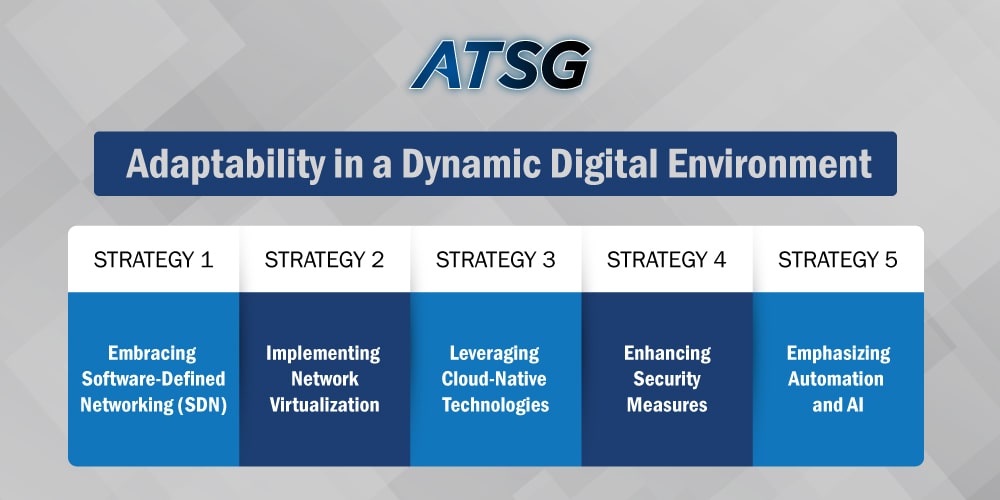Network transformation signifies a paradigm shift in the way organizations approach connectivity. It involves adopting innovative technologies and strategies to optimize network performance, enhance security, and seamlessly adapt to evolving business needs. The journey towards network transformation is fueled by the ever-growing demands for connectivity, and the need to stay competitive in an increasingly digital world.
In today’s digital age, where connectivity is the backbone of operations across industries, businesses face an imperative need to revolutionize their networks. The evolving landscape demands agility, scalability, and robust security measures to navigate the complexities of the digital environment.

Traditional networking approaches often fall short of meeting these demands, prompting the need for network transformation. This article delves into five key strategies to unleash network transformation, and navigate the digital landscape effectively.
Defining Network Transformation
Network transformation is not just about upgrading or expanding the network infrastructure. It involves a complete overhaul of the infrastructure, processes, and technologies. It includes adopting cutting-edge solutions to address the challenges posed by traditional networking approaches, and preparing for future trends and threats. To keep up with the pace of digital acceleration, organizations must understand the importance of network transformation.
Key areas of focus include an agile infrastructure, security by design, cloud-enabled connectivity, and automated management. Moving from rigid hardware to software-defined networks (SDNs) improves scalability, adaptability, and responsiveness. Robust security measures embedded into the network fabric protect against evolving threats. Integrating seamlessly with cloud services optimizes operations, while AI and automation tools simplify network management, while also reducing human error.
The Evolving Landscape of Connectivity
Businesses today rely heavily on connectivity to facilitate communications, data exchange, and collaboration. However, the advent of connected devices, cloud computing, and data-intensive applications has put pressure on traditional networks, revealing their limitations and inefficiencies. To keep up with the demands of the modern world, many enterprises are now exploring agile networking solutions to broaden the scope of their digital transformation efforts.
To achieve success, it is essential for data centers, branches of the enterprise, and applications to be well-connected, and this is where the network comes in. Through the use of network services and wide-area networks (WAN), businesses can connect all aspects of their operations.
The process of digital transformation encompasses a variety of solutions, including cloud environments, network services, and SD-WAN (Software-Defined Wide Area Network). Understanding each one is crucial to achieving the goals of modern enterprises.
The Importance of Network Transformation
Network transformation is a crucial step for businesses that want to succeed in the digital age. By embracing network transformation, organizations can enjoy several benefits, such as improved agility, scalability, security, and streamlined operations. While there are plenty of advantages to consider, such as better performance, enhanced scalability, security, cost-effectiveness, and simplified management, there are also challenges that can hinder a network transformation initiative.
The complexity of such initiatives is a major challenge, and if an organization’s existing technology is not at par with its needs, it can lead to integration problems and roadblocks during the data migration process. From an organizational perspective, change management and skills gaps within an organization’s workforce can make training and upskilling initiatives a crucial investment.
Rebuilding a core element of an organization, particularly something as complex as networks, is never an easy task. However, despite the challenges, IT leaders will soon face growing pressure to transform their organization’s network, to drive innovation further.
The Limitations of Traditional Networks
In today’s fast-paced business environment, traditional networking approaches have become increasingly outdated. They are often unable to cope with the ever-changing requirements of modern businesses. The use of legacy infrastructure, rigid architectures, and manual configurations can significantly limit an organization’s ability to adapt to changing demands effectively, and hinders its ability to scale and remain agile.
Unfortunately, these limitations can lead to several challenges that can have a significant impact on business operations. For instance, traditional networks are often more vulnerable to security threats, network failure, and connectivity issues. Additionally, they can experience sluggish performance, which can impact productivity and customer satisfaction.
Given these challenges, organizations need to consider modernizing their networks by adopting more advanced technologies, such as software-defined networking (SDN) and network function virtualization (NFV). These technologies can help organizations achieve greater flexibility, scalability and agility, while also improving overall network security, reliability, and performance.
Adaptability in a Dynamic Digital Environment
In a fast-paced digital environment, adaptability is key to staying ahead of the curve. Network transformation empowers businesses to embrace change proactively, enabling them to scale resources on demand, optimize performance, and respond swiftly to evolving threats as well as opportunities.
Here are 5 key network transformation strategies for organizations to pursue:

Strategy 1:
Embracing Software-Defined Networking (SDN)
Software-defined networking (SDN) represents a fundamental shift in network architecture, de-coupling control, and data planes to enable centralized management and programmability. By abstracting network infrastructure from the underlying hardware, SDN enhances flexibility, scalability, and automation, laying the foundation for agile and responsive networks. ATSG, a global leader in Managed Network Services (MNS) and SD-WAN capabilities, offers cutting-edge solutions powered by the ATSG OPTX™ Platform.
Strategy 2:
Implementing Network Virtualization
Network virtualization entails abstracting network resources from the underlying hardware, to create virtualized instances, enabling greater resource utilization and flexibility. By de-coupling network services from physical infrastructure, businesses can achieve enhanced scalability, simplified management, and reduced costs.
Strategy 3:
Leveraging Cloud-Native Technologies
Cloud-native technologies offer un-paralleled agility and scalability, enabling businesses to leverage cloud resources seamlessly. By embracing cloud-native solutions, organizations can accelerate application deployment, optimize resource utilization, and foster innovation in today’s dynamic digital landscape.
Strategy 4:
Enhancing Security Measures
In an era marred by cyber threats and data breaches, Cybersecurity is paramount to safeguarding sensitive information, and preserving business continuity (BC). Network transformation encompasses implementing robust security measures, including proactive threat detection, encryption, and access controls, to mitigate risks and ensure regulatory compliance.
Strategy 5:
Emphasizing Automation and AI
Automation and artificial intelligence (AI) play a vital role in streamlining network operations, minimizing human errors, and enhancing efficiency. By automating routine tasks and leveraging AI for predictive analytics, organizations can optimize network performance, detect anomalies, and pre-emptively address potential issues before they escalate.
Managed Network Services (MNS) and ATSG
As organizations navigate the intricate landscape of network transformation, leveraging Managed Network Services (MNS) becomes a strategic choice. Adopting future trends and technologies can cater to enhancing the network’s resilience. In today’s digital environment however, partnering with the right service provider is quite essential.
ATSG stands out as a trusted partner in this endeavor, offering – a comprehensive solution designed to optimize network performance, resilience, visibility and security. The AI powered network management platform of ATSG provides invaluable capabilities, such as AIOps, Business Impact Monitoring (BIM), and Root Cause Analysis (RCA).
AIOps empowers organizations with intelligent, automated operations, ensuring networks are responsive and adaptive. BIM allows for real-time monitoring of mission-critical applications, providing insights into performance and potential bottlenecks.
RCA digs deep to identify the root causes of issues, enabling swift and effective resolution. With ATSG’s OPTX™ Platform, organizations can achieve not just operational efficiency, but a transformative shift towards better organizational performance.
ATSG stands at the forefront of network transformation, and has also been recognized as a Leader in the 2023 Gartner® Magic Quadrant™ for Managed Network Services (MNS). We empower businesses to embark on their network transformation journey with confidence, leveraging cutting-edge solutions tailored to their unique needs.
Contact ATSG for innovative Managed IT Services, Technology, Cybersecurity and Cloud Computing solutions for your enterprise.
Network transformation involves a comprehensive upgrade of the network infrastructure, processes, and technologies. It also involves prioritizing agility, scalability, and security. Unlike traditional networking methods, that depend on inflexible designs and manual setups, network transformation employs advanced solutions like SDN, virtualization, and cloud-native technologies to seamlessly cater to changing business needs.
SDN brings many benefits, such as improved flexibility, scalability, and automation. With centralized management and simplified configurations, it allows seamless integration with cloud environments, empowering businesses to adapt quickly, and optimize network performance.
Network virtualization involves creating virtualized instances of network resources, for greater agility and optimal resource utilization. Businesses can implement it by abstracting network resources from the underlying hardware layer.




